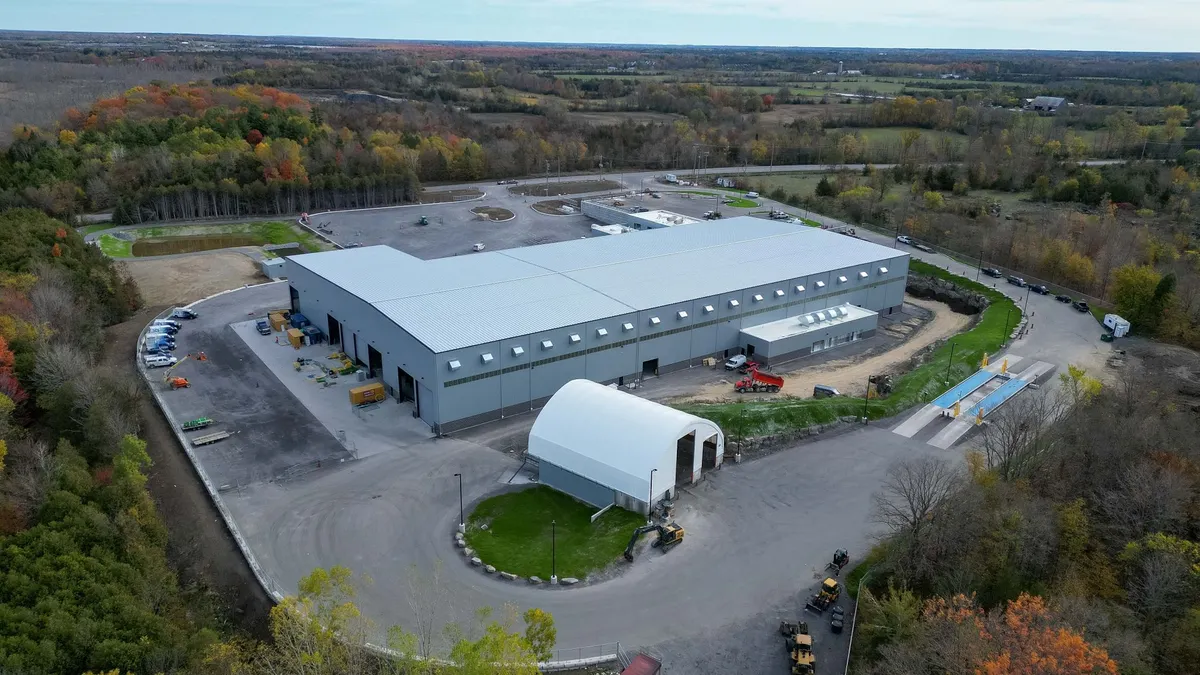As electric collection trucks become more common, companies such as Coastal Waste and Recycling are beginning to experiment with electrified heavy equipment as well.
Earlier this year, the Florida-based company announced plans to pilot a Volvo EC230 Electric excavator while also purchasing a Class 8 electric collection truck from Volvo Group subsidiary Mack Trucks.
“We are excited to add both pieces of equipment to our fleet,” said CEO Brendon Pantano in a release at the time. As the first private hauler in Florida to invest in electric, he said the firm “looks forward to harnessing the strength of this strategic move to further elevate innovation in our operations.”
Coastal has deployed its EC230 for MRF tasks and green waste operations at one of its waste processing sites north of Miami. The company already operated a large fleet of Volvo EC220 diesel excavators, which are considered virtually identical to the EC230 aside from the power source.
“We all knew eventually we'd have to be looking at different energy sources. It was the perfect opportunity because with their similarity, the learning curve for the transition was simple,” said Martin Mattsson, Volvo Construction Equipment’s director of strategic accounts in the waste industry. Furthermore, he said the arrangement will allow for side-by-side comparison in actual operations.
Coastal also worked closely with Mack to prepare for delivery of the truck.
“We had to look at numerous factors; including the charging apparatus and matching the vehicle to the application they wanted to use it on,” said Tyler Ohlmansiek, director of E-Mobility Sales at Mack Trucks. “We evaluated everything from the route density, to where it would be housed and how it would be run.”
Mack used a route recorder tool to analyze runs for the new collection truck, while assuring a service pipeline through a certified local Nextran Truck Centers dealership. Ohlmansiek said the company’s E-Mobility Ecosystem also provided resources, expertise, analysis and technical support to help ease the transition.
“We worked with Coastal’s in-house electrician to design and site the charging station for the truck at a facility where they regularly housed vehicles. We were able to take advantage of power already on site for some of their other uses,” he said.
Evolving performance
Battery-electric collection trucks are becoming an increasingly visible trend and industry groups are working to help advance research in this area.
The Solid Waste Association of North America has begun developing a survey of field results with alternative fuel and electric powered vehicles. Jeremy O’Brien, SWANA’s director of applied research, said the goal is to provide data that can help guide decision making during the transition to electric.
For example, he said SWANA found that Ocala, Florida, operates its electric trucks at an energy cost of about 66 cents per mile, comparing favorably with an average fuel expense for diesel trucks of $1.30 per mile. O’Brien said he hasn’t seen a central clearinghouse for operational performance data on electric collection vehicles, but said information is available. He suggested that anyone considering the conversion to electric should find an operation close in size to theirs with a similar service environment and ask them how they are doing before gradually making the transition.
Ray Gallant, Volvo Construction Equipment’s vice president for sustainability and productivity services, believes the time is right for going electric across collection vehicles and heavy equipment. While the transition so far has mainly been focused on converting existing equipment designs to the new power source, he expects that will evolve.
“The second and third generations are when you start designing around the fact that you are using electric drive and not only replace the power system, but use the characteristics of electric drive to add new capabilities to become more efficient and improve ease of operation,” he said. Gallant predicts that these future generations of heavy equipment will take further advantage of telematics, artificial intelligence, autonomous operation and other emerging technologies.
Already, there are notable differences for operators in this first generation.
“An electric motor can operate at 20% of full power or 80%, it doesn't matter. The variable load doesn't bother it at all,” Gallant said. “There is never any need to throttle the engine and rev up to perform a lift.”
Additionally, there are no exhaust fumes or engine noises to contend with, which the company said is a good fit for densely occupied urban areas or indoor environments. Mattsson said operators at Coastal have also been impressed by the cool climate and responsive controls in the cabin.
“No one argues about the performance any more,” he said.
Energy and maintenance
Electric heavy equipment still remains a newer application than collection vehicles, with some fundamental challenges to resolve in the coming years.
“The first is the duty cycle and battery capacity, and understanding when we have to recharge,” said Gallant.
Coastal factored these charging cycles into its daily work schedule for the EC230.
“They charge it overnight and start each morning with a full charge,” said Mattsson. “Around midday, they take it off duty and charge it for a couple of hours, doing what's called an opportunity charge, before moving on to the next task.”
This particular unit is housed and operated from a separate site than Coastal’s Mack LR collection truck, but it uses the same model of charger which allows for interoperability across applications and facilities.
Cost is also a factor for customers. Volvo encourages them to consider that within the context of potential maintenance savings, because there are a smaller number of moving parts in the electric excavator than a diesel model.
Gallant said that electric heavy equipment could yield a 60% to 80% operational cost savings compared with diesel. And when factoring in energy costs, he estimates there could be a 30% to 35% reduction in overall costs during the life of the unit.
Volvo currently has seven models of battery-electric construction equipment commercialized and plans to continue building its lineup of heavy equipment powered by alternative fuels. Its current offering includes six 48-volt models in various applications, along with the 600-volt EC230.
Gallant said the company's goal is “to have sustainable powered models for pretty well everything we make, where practicable, reasonable and feasible” over the next several years.
“They may not all be battery electric,” he said. “Some may be grid-connected machines, some of them may be hydrogen powered, with some, we may have to go with [hydrotreated vegetable oil] and alternate fuels. There are a variety of technologies coming into play.”


















